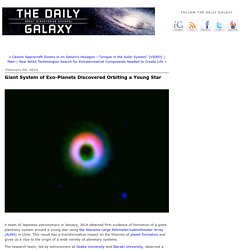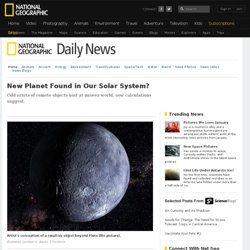

Www.forbes. Do other planets have an effect in Earth's rotation and revolution? Yes they do, and this is a great way to introduce perturbation theory.

Exact solutions to n-body problems where n is greater than 2 are hard to find. It has been accomplished in the case of 3 and 4 bodies, and a general solution where bodies do not collide has also been found, but these problems are extremely complex. One way to get around this complexity is to start with a two body problem (like mercury orbiting the sun) and then perturb the solution to reflect the effects of other celestial bodies. This is possible especially since the mass of the sun is so much greater than the mass of all the other planets in orbit.
UPDATE: To modify to reflect Ron's comments, a good way to understand how other planets effect each others orbits is to look at the anomalous precession of mercury which can be visualized here. Scientists Find Strong Evidence That the Earth Was Hit Head-On by a Mars-Sized Planet. The early solar system was, for lack of a better term, a chaotic hellscape.

"Did Life First Appear on Alien Worlds 12-13 Billion Years Ago?" This means that planets that could potentially have supported life may have formed eight, ten, maybe even twelve billion years ago.

Surveys do detect a decrease in the number of planet-hosting stars with decreasing metallicity, but this drop is much shallower for terrestrial planets than it is for gas giants. Giant System of Exo-Planets Discovered Orbiting a Young Star. By measuring the density of dust in the densest part of the ring, the astronomers found that it is highly possible that Jupiter-like giant gaseous planets or Earth-like rocky planets are now being formed in that region.

This region is far from the central star, about 5 times larger than the distance between the Sun and the Neptune. This is the first firm evidence of planet formation found so far from the central star in a protoplanetary disk. The research team plans further observations of HD142527 with ALMA for closer investigation, as well as other protoplanetary disks to have a comprehensive understanding of the planet formation in general.
Best Photo Yet of An Exoplanet. It's just a few small pixels, but the image above marks a giant leap for our capacity to explore worlds beyond the influence of the sun.

Taken with the Gemini Planet Imager, recently fitted to the Gemini South telescope in Chile, the bright dot represents Beta Pictoris b, one of the most famous planets beyond the solar system. The larger circle, looking like the freeze frame of a drop of water after it has landed on a pond, is centred on the star Beta Pictoris itself, after its light was subtracted so that it would not overwhelm the planet itself.
The Planet Imager was specifically designed for such work, with “Advanced adaptive optics, diffraction control, a near-infrared spectrograph, and an imaging polarimeter” according to the team that took this image. The twenty one institutions that came together to make the image possible hailed the photo as “an order of magnitude better than conventional adaptive optics imagers” . Future targets will be harder, however. Photo Gallery. Transiting Exoplanet With Longest Year Discovered.
Astronomers have identified an exoplanet that has the longest year ever discovered outside of our solar system at 704 days.

The research was lead by David Kipping of the Harvard-Smithsonian Center for Astrophysics and has been accepted for publication in The Astrophysical Journal. Kepler-421b is about 1,000 light-years away in the constellation Lyra. It is about the same size as Uranus and exists over 177 million km away from its orange K-type parent star, taking 704 days to complete a single orbit. Of course, 704 days doesn’t sound like much when compared to our own solar system. Mars circles the Sun every 780 days and Neptune takes a staggering 164.8 years to complete an orbit. Exoplanets are typically identified when they transit their parent star, blocking out some of the light. The planet was spotted with NASA’s Kepler telescope.
Strange. New Planet System Found—May Have Hidden "Super Earth" A newly discovered planetary system orbiting a sunlike star may conceal a rare super- Earth , according to data from NASA's Kepler space telescope . Launched last March, Kepler was designed to look for extrasolar planets, aka exoplanets, via transits—the periodic dimming of light from stars due to planets passing in front them, as seen from the telescope's vantage point. (Read about Kepler's first planet discoveries .) After analyzing seven months' worth of data from Kepler, a team led by Matt Holman of the Harvard-Smithsonian Center for Astrophysics found two transiting exoplanets orbiting the star Kepler-9, which lies about 2,300 light-years from Earth.
One of the planets, dubbed Kepler-9b, takes just over 19 days to orbit its star. The other, Kepler-9c, takes almost 39 days to complete an orbit. The researchers noticed that both planets' orbital periods speed up and slow down at regular intervals. New Planet Found in Our Solar System? Richard A.

Lovett in Timberline Lodge, Oregon Too far out to be easily spotted by telescopes, the potential unseen planet appears to be making its presence felt by disturbing the orbits of so-called Kuiper belt objects, said Rodney Gomes, an astronomer at the National Observatory of Brazil in Rio de Janeiro. Kuiper belt objects are small icy bodies—including some dwarf planets —that lie beyond the orbit of Neptune .